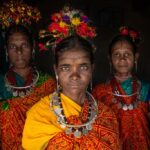Majuli, in Assam, is known for being the world’s largest river island. But there’s something else that makes Majuli special, and that’s its masks.
The tradition of making masks in Majuli is over 500 years old. It is believed that during the 15th century, Guru Srimanta Sankardeva, during the neo-Vaishnavite movement, created the first mask and performed the Cihna Yatra.
The Cihna Yatra was the first drama in Assam. It involved creating a large painting of Krishna, known as Cihna, alongside a play or bhaona. There were also dance, music, and masks involved.
And this is how the tradition of mask-making started in Assam.
The Majuli masks are built on bamboo frames layered with a unique clay called kumar matti, which is sourced from the depths of the Brahmaputra river. Mixed with cow dung, this mud is applied onto the frame wrapped with a thin cloth and left to dry in the sun. Finally, vibrant colours are added to complete the mask.
There are hundreds of satras in Assam, and among them is Shamaguri satra, which is famous worldwide for its masks.
Now, the Indian government has bestowed a Geographical Indicator (GI) tag on this tradition, giving Majuli mask a new recognition.
Also Read: Festivals in India: What’s behind the masks in Leh’s Hemis Festival?
Ashwini Kumar Shukla is a journalist based in Jharkhand. He is an alumnus of the Indian Institute of Mass Communication and writes about rural India, gender, society and culture.







